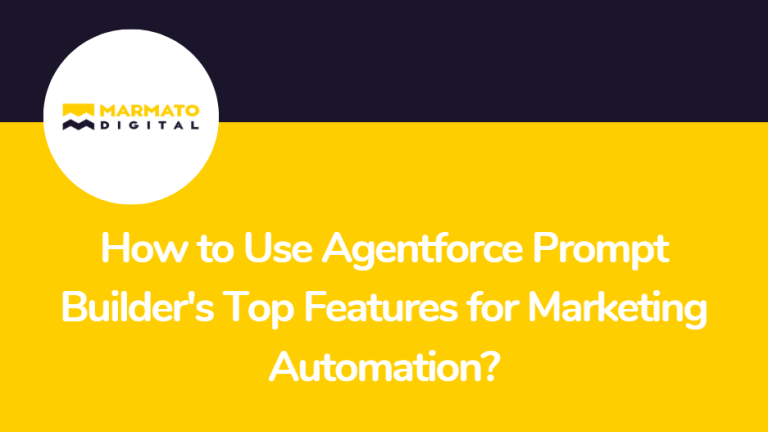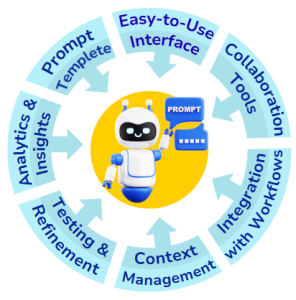Agentforce Prompt Builder is a tool inside Salesforce’s Agentforce platform that helps teams design, test, and manage AI prompts in a structured way. Instead of typing long instructions into a chatbot or large language model, Prompt Builder gives teams an organized space to create prompts that are reusable, consistent, and aligned with business goals.
For companies using AI to support sales, marketing, and service, this tool makes it easier to get high-quality results without deep technical skills. In this article, we’ll look at the top features of Agentforce Prompt Builder and how marketing teams can use it to make automation smarter and more effective.

Why Prompt Builder matters for Marketing Teams?
Marketing automation tools are powerful, but they don’t create content on their own. Without clear, personalized messages, even the best automation system falls flat.
Prompt Builder solves this by giving marketers a way to:
- Create consistent messages across campaigns.
- Personalize content for different customer groups.
- Scale marketing without adding extra manual work.
For marketers, this means less time writing from scratch and more time focusing on strategy and results.
Key Features that support Marketing Automation:
The key Agentforce Prompt Builder features increase productivity, reduce manual work, and ensure AI responses are both consistent and high-quality. Most importantly, it makes advanced AI usable by everyone, not just technical specialists.

1. Easy-to-Use Interface:
Agentforce Prompt Builder is designed to be simple. It provides a guided interface, so users don’t have to know advanced prompt engineering. Both technical experts and business users can quickly create prompts. The clear layout helps reduce setup time and makes it easy for anyone in the organization to start using AI.
2. Prompt Templates:
One of the most useful features is the availability of templates. Teams can use prebuilt structures for common business needs such as customer support responses, marketing messages, or sales outreach. Templates save time, improve consistency, and ensure that teams don’t need to start from scratch every time.
3. Context Management:
A big challenge in AI use is making sure the responses reflect the company’s voice, knowledge, and rules. With context management, teams can add business details, tone guidelines, and reference materials to the prompts. This keeps the outputs on-brand and accurate, while also making them more useful to the end customer.
4. Testing and Refinement:
Prompt Builder allows users to preview results before putting prompts into real workflows. Teams can test different versions, make changes, and compare results. This step avoids errors and saves time because prompts can be improved before being used in front of customers or prospects.
5. Collaboration Tools:
AI is not just for one person: it’s for the whole team. Prompt Builder supports collaboration by letting multiple users work together on prompts. A shared library helps sales, marketing, and support teams’ access and reuse prompts across the organization. This avoids duplication and makes teamwork easier.
6. Integration with Workflows:
Prompts created in Agentforce Prompt Builder can connect directly to Salesforce workflows and apps. For example, a prompt can be tied to a sales process to generate personalized emails or used in a service workflow to suggest customer replies. This integration ensures AI is not separate but part of the daily business process.
7. Analytics and Insights:
Another valuable feature is tracking performance. Prompt Builder includes analytics so teams can see which prompts deliver the best results. By reviewing usage data and response quality, teams can make decisions based on facts, not guesses. Over time, this makes prompts more effective and aligned with business goals.
Practical Ways to Use Prompt Builder in Marketing Automation:
Here are a few practical ways of how marketing teams can put Prompt Builder to work:
• Setting Up Prompts for Marketing Tasks:
Prompt Builder offers ready-made templates, so marketers don’t need to start from scratch. For example, you can:
- Generate email subject lines.
- Write campaign copy for ads or newsletters.
- Create variations of call-to-action text.
By adding context like your brand tone, target audience, or campaign goals, the AI produces content that feels tailored and professional.
• Personalization with Context Management:
Personalization is key to strong marketing. With Prompt Builder, you can feed customer data and segments into prompts. This allows AI to write messages that match each customer’s profile.
For example:
- Sending product recommendations based on past purchases.
- Writing nurture emails that speak to a customer’s stage in the buying journey.
- Keeping the language and tone aligned with your brand voice.
This makes automation feel less like “mass marketing” and more like one-on-one communication.
• Multi-Channel Campaign Support:
Modern marketing happens across email, SMS, chat, and more. Prompt Builder can create messages for all these channels.
For example:
- An email campaign introducing a new product.
- A chatbot follows up with FAQs.
- A matching SMS alert for time-sensitive offers.
Using Prompt Builder ensures your message stays consistent across every channel, so customers experience a smooth journey.
• Testing and Optimizing Campaign Content:
Great marketing doesn’t stop at creating content; it requires testing. With Prompt Builder, you can preview prompts and refine them before launching.
You can also create different variations and test which one performs best. Over time, these small improvements lead to higher engagement and better conversion rates.
• Collaboration Between Teams:
Marketing doesn’t work in isolation. Sales and service teams also interact with customers and need to deliver consistent messaging.
Prompt Builder allows different teams to work together by sharing a library of prompts. This makes sure that whether it’s a marketing email, a sales follow-up, or a service reply, the tone and message feel aligned.
Measuring Success with Analytics:
Prompt Builder also includes analytics to show how prompts are performing. Marketers can track:
- Engagement (open rates, clicks).
- Conversions (leads or sales generated).
- Quality of responses generated.
This data helps teams learn which prompts work best and adjust for future campaigns.
Best Practices for Marketing Teams:
To get the most out of Prompt Builder, marketing teams should:
- Start small by testing prompts on a single campaign.
- Reuse successful prompt templates across channels.
- Keep refining prompts based on real data and results.
- Involve sales and service teams to keep messaging unified.
Conclusion:
Agentforce Prompt Builder gives marketing teams a powerful way to scale automation without losing the human touch. Its top features make it easy to create content that is consistent, personalized, and effective. If your organization is exploring how to bring AI into daily workflows, this tool is a strong place to start.
Want to get the most out of Agentforce Prompt Builder for your marketing automation?
Subscribe to Newsletter
Get our latest blogs directly to your inbox.

